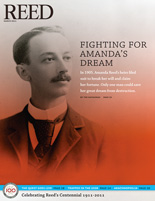
IRIS login | Reed College home Volume 90, No. 1: March 2011
Classic Lectures
What Hum 110 Is All About (continued)

Hum 110 is truly multidisciplinary, taught by 20 to 25 members of the faculty typically representing 8 or 9 departments including English, history, philosophy, religion, art history, political science, French, Spanish, and classics. Each member of the faculty teaches his or her own conference throughout the year. Conferences are composed of 15 or 16 students, and meet 3 hours per week. While the so-called “Reed conference method” in fact varies considerably from faculty member to faculty member, in almost all cases the principal goal is to teach through conversation, understanding conversation to be a kind of “unrehearsed intellectual adventure”1 where student-to-student interaction is crucial and where the faculty member functions, to the degree possible, as merely one interlocutor among many.
In addition to conferences, however, the course also includes three hours of required course-wide lectures per week. It is a long-standing Reed tradition that the entire freshman class gathers at 9 a.m. every Monday, Wednesday, and Friday for Hum lecture. The lectures themselves are apportioned more or less equally among the teaching staff, hence most faculty offer two or three lectures per semester.
The Tradition of Hum Lectures
Lectures in Hum 110 are designed, in large part, to provide agendas for conferences. During lectures, faculty present historical and scholarly background, raise interpretive questions, and make arguments. In doing so, students and faculty encounter what is, in effect, yet another text—a secondary text—to be analyzed and debated together with the day’s primary text, thereby helping, in the best of circumstances, to enrich and elevate conference discussions. As such, the lectures play a distinctive and extremely important pedagogical role.
Reedies are expected to approach their studies in a manner that might be called scholarly. They are not necessarily expected to be full-fledged scholars in the strict sense—ours is an undergraduate education, not a professional one—but they are expected to acquire the habits and dispositions characteristic of people whose primary goal is not to receive, store, and reproduce information that is already well established but, rather, to engage in original, open-ended, critical inquiry. In this context, Hum lectures are intended to serve as models of scholarly argument. They are offered to students as exemplars of what it might mean to formulate and defend an original thesis of at least some intellectual consequence.
A notable feature of Hum 110 is that the study of antiquity becomes, for many faculty, a kind of second field specialization. Indeed, this is not really a course for amateurs. Over time, most faculty, regardless of discipline, develop considerable scholarly expertise in ancient history, society, literature, and art, such that conferences can be conducted at a high level and lectures can be serious, challenging, and informed by the best and most recent scholarship. Over the years, faculty have taken their lecture responsibilities seriously, largely for pedagogical reasons, but perhaps also because they are lecturing to colleagues as well as students. Of course, lecture styles vary considerably, as does the pedagogical effectiveness of the lectures themselves. In any given year, however, the various lectures compose, collectively, a fairly systematic approach to the ancient world of Greece.


LATEST COMMENTS
steve-jobs-1976 I knew Steve Jobs when he was on the second floor of Quincy. (Fall...
Utnapishtim - 2 weeks ago
Prof. Mason Drukman [political science 1964–70] This is gold, pure gold. God bless, Prof. Drukman.
puredog - 1 month ago
virginia-davis-1965 Such a good friend & compatriot in the day of Satyricon...
czarchasm - 4 months ago
John Peara Baba 1990 John died of a broken heart from losing his mom and then his...
kodachrome - 7 months ago
Carol Sawyer 1962 Who wrote this obit? I'm writing something about Carol Sawyer...
MsLaurie Pepper - 8 months ago
William W. Wissman MAT 1969 ...and THREE sisters. Sabra, the oldest, Mary, the middle, and...
riclf - 10 months ago